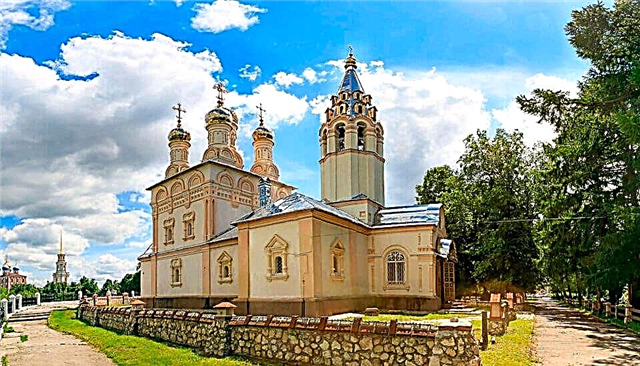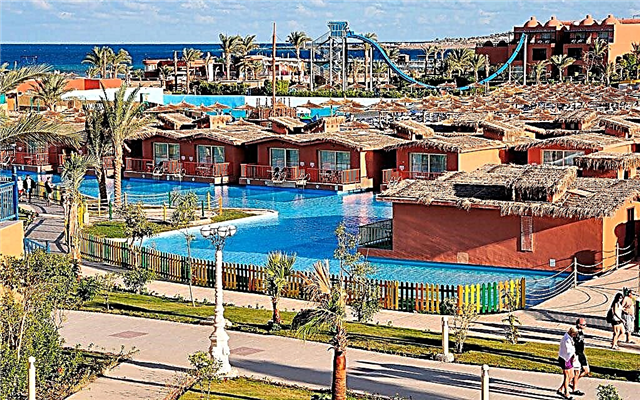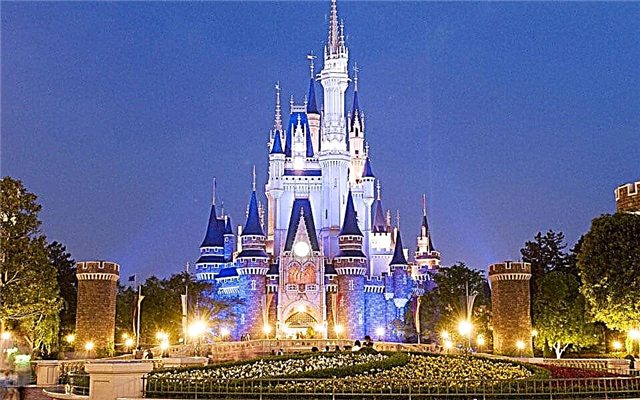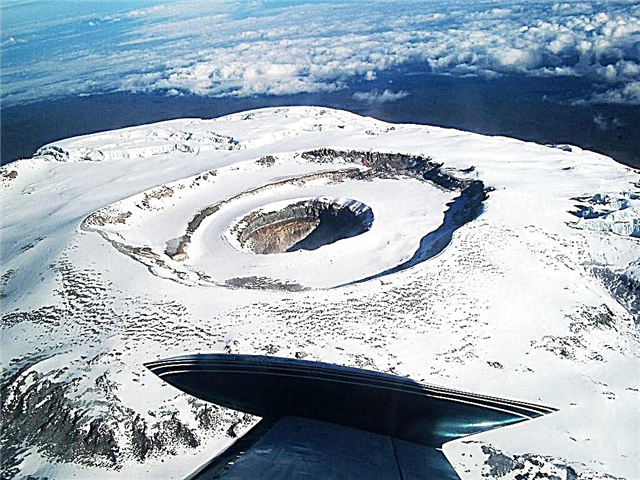Kilimanjaro is an unusual word for the Russian language that has become attractive to most Russians since childhood, and many, like the heroes of Hemingway, have a dream to visit these wonderful places and, perhaps, even climb the "Crown of Tanzania". This is what the highest mountain in Africa is called (literally translated from Swahili - sparkling mountain).
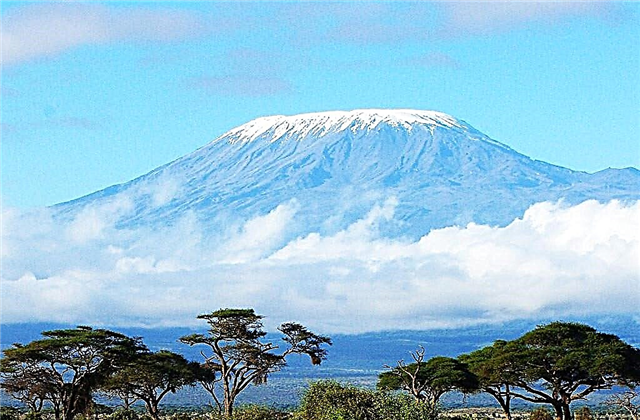
Country symbol
The snow-white top of Kilimanjaro, like the mountain itself - a symbol of the country, towering over the savannah, is visible from afar. Its height is 5895 m, and its base diameter is 60 km. In hot weather, the bluish tint of the base of the mountain blends in with the surrounding landscape, giving the impression that the upper part is hanging in the air. This sensation is enhanced if there is a slight cloudiness: clouds usually cover the lower part of the mountain, leaving only the snowy top for viewing.

Mount Kilimanjaro is so huge that its own special climate is formed at its foot. The wind, hitting such a large obstacle, dumps moisture particles in the form of rain or snow. Good soil irrigation is known to promote plant diversity. Therefore, the flora on Kilimanjaro is much richer than on the surrounding plain. In the lower part of the mountain, tropical plants grow (in particular, corn, coffee), further - up to an altitude of about 3000m - the mountain is covered with jungle, even higher - lichens and mosses.

Crown of tanzania
Back in the Middle Ages, travelers used Kilimanjaro as a landmark, and the first written records of this volcano (namely, a volcano with a flat top and a crater) date back to the 13th century. Kilimanjaro was first described by Chinese sailors off the African coast. They talked about a white peak rising to the sky from the depths of the mainland.

However, medieval memories of the snowy mountain were for a long time perceived by the compatriots of the pioneers as fiction: no one could believe that an ice peak could be located practically at the equator (3 degrees south latitude). Only in the 19th century - after the expedition undertaken by the Europeans in 1889 - was it marked on geographical maps.

Now the territory near Mount Kilimanjaro has been declared a national park with an area of 7500 sq. M. This status was given to the land in 1961 after Tanzania became an independent country. Kilimanjaro National Park has been included in the UNESCO list since 1987. By the way, Kilimanjaro is a mountain formed from three separate volcanoes. Over the long years of numerous eruptions, they seemed to be stuck together into a single formation, but individual parts are still distinguishable. The oldest Shira volcano is the western part of the main mountain. According to scientists, initially it was much higher, but, as they believe, it collapsed as a result of a particularly strong eruption. Now its height is 3810 m.

The younger volcano - Mavenzi - adjoins the base from the east and now looks like a peak with a height of 5334 m. The final appearance of Kilimanjaro was formed by the newest and highest volcano - Kibo. It was he who gave the peak a characteristic flat shape with eternal ice on the surface.
However, every year the snow mass is decreasing. A number of experts call the cause of this process the warming up of the volcano, according to others, global warming is to blame. Be that as it may, they all admit that the Kilimanjaro snow cap has become much smaller than it was in the last century, and they do not exclude that in 200 years it will completely disappear.

How to conquer Kilimanjaro
Thousands of tourists come to Tanzania every year to try to climb the most famous peak in Africa. You can climb it on foot, which makes the mountain attractive not only for climbers, but also for ordinary lovers of mountain travel. However, not everyone succeeds: during the ascent there are places (although not often), which are difficult to overcome: you have to rely on all the limbs at once.

The most difficult to climb is the Mavenzi volcano: to conquer this part of Kilimanjaro requires climbing skills on rocks, ice and snow. It is not very difficult to climb the highest point - Uhuru Peak (Kibo Volcano), but in this case it will take time for acclimatization. By the way, it is the height that is the main obstacle for the majority, because at a certain moment (some earlier, some later) conquerors find it difficult to breathe, headaches and nausea appear. This is what tourists call the most difficult test, but that is why the hikes are designed for several days.

Uhuru Peak was first conquered in 1889 by Hans Mayer of the first European expedition. The centenary of this event in Tanzania was celebrated on a grand scale. Surprisingly, the very first guide was present at the festival, who helped the first climbers. In 1989 he was 118 years old. Now about half of the travelers who started from the bottom reach the top of Uhuru, two-thirds manage to reach a height of 5681 meters (Gilmand's height).

For less prepared people, local travel agencies have prepared very easy routes: Marangu, Rongai and Mashame.
The oldest and most popular is the Marangu route (also called the "Coca-Cola Way"). On this hike - the only one of all - tourists do not need to take tents with them, as they already have places to rest on the way. These are 3 mountain huts (lodges), the first of which (Mandara) is located at an altitude of 2700 m, the second (Horombo) - at an altitude of 3700 m and the third (Kibo) - at an altitude of 4700 m. 80 people, others are smaller) and a dining area. The conditions are not particularly comfortable. The journey takes 5-6 days. The Mashame route is designed for 6-7 days, it is considered more difficult than Marangu, but it is also accessible to ordinary people.

The Rongai route is currently the least known, but very interesting. It runs along the northern slope of Kilimanjaro, where the local flora and fauna are most widely represented. Here you can see many of the characteristic animals. It takes 5-6 days.

Each route has its own characteristics and rules that must be strictly followed. For example, there are paths that you can only climb - going down is strictly prohibited. There are five such paths on Kilimanjaro. Three trails can only be descended, and only one - Marangu - is used for both ascent and descent.
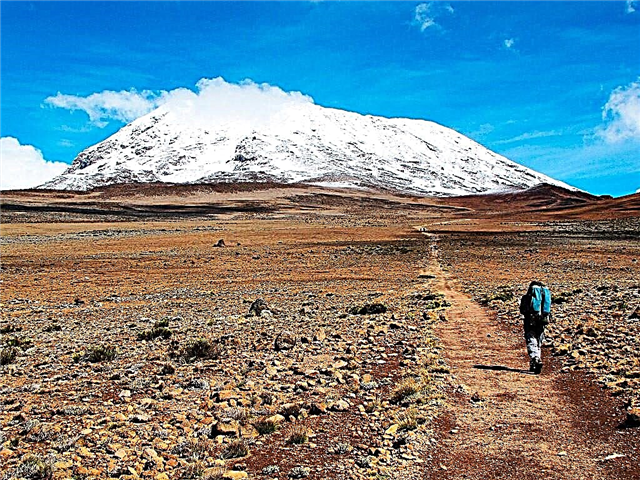
At the 4 km mark, the trails of all routes run into the so-called Kibo Ring (as the name suggests, this trail encircles the entire mountain), from where the ascent begins directly to the very top and crater of Kibo volcano. At this point, you can also choose from three options: follow the Glacier Arrow Trail (or the Western Breach Trail), the Barafu Trail, and another untitled trail that leads to Gilmand Altitude and the Volcano Crater.
Now the tourists are finally at their destination: they rise above the clouds, touch the eternal ice, look inside the volcano, which still shows signs of activity (smoke and the characteristic smell of sulfur). At this moment, everyone who conquered Kilimanjaro is unanimous in their feelings: the difficulties of walking on foot are immediately forgotten, only delight from the surrounding beauty remains.

Local guides will tell you which route to take. It should be remembered that climbing Kilimanjaro without a guide is strictly prohibited. In the town of Moshi, closest to the volcano, there are a huge number of travel agencies offering their services. The cost of the trip depends on the number of people in the group, but on average it is about $ 1000 per person. Locals are ready not only to accompany tourists on the way, but also to carry their things, as well as to cook food - it all depends on the wishes and financial capabilities of the travelers.

Travel agencies operate all year round.Accordingly, you can go on a hike whenever you want, but do not forget about the weather conditions: there is a rainy season in Tanzania. Many admit that the best time to travel is July and August. At this time, as a rule, there are no tropical showers, the heat is easily tolerated. Basically, travelers will not be mistaken if they come here between August and October and from January to March. But even at this time, you need to remember that you can find yourself on Kilimanjaro both in the tropics and in almost polar conditions: if at the foot of the mountain the average annual temperature is +30 ° C, then at an altitude of 3000 m - only + 5 ... 15 ° C , and at night the thermometer can drop below zero. Thus, at the beginning of the journey it will be very comfortable in shorts and a T-shirt, but at the height you will need completely different clothes. Do not forget about this when going on the road. There must be room in the suitcase for warm socks, gloves, warm waterproof trousers and a jacket.
What else to do on Kilimanjaro?
For those who do not want to go on a multi-day mountain hike, one-day excursions up the mountain are offered: you don't have to climb very high, but you will get an idea of the "crown of Tanzania". There are many other entertainments:
- visiting the Serengeti and Tarangire National Parks - the largest reserves of picturesque African nature; parks are located near Kilimanjaro
- jeep safari in the savannah and jungle (cars have lifting hatches and equipment for video and photography)
- a trip to the village of the Chagga tribe, where you can get acquainted with the life of local residents, as well as look at the coffee and banana plantations

Nevertheless, experienced travelers strongly recommend trying to master the ascent. Kilimanjaro is the only real mountain in the world, which you can climb without experience, and then be proud of yourself for a long time and feel like a real climber.
If you want to continue your trip to Africa, I recommend reading the Uganda travel guide. Or maybe you are interested in extreme tours? Then I recommend reading the life hack Climbing Mount Kinabalu.

